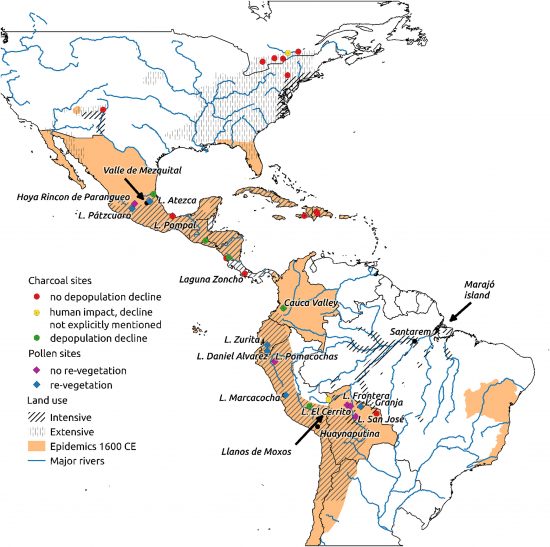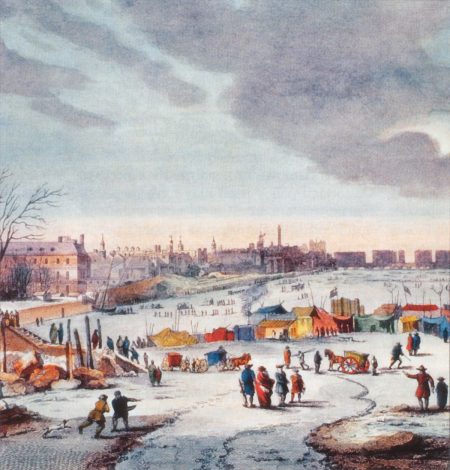January 31, 2019 – I love a historical mystery like this one. According to a study by researchers from University College London, in the United Kingdom, the European assault on the Americas led to an epic holocaust wiping out more than 90% of the Indigenous people within a little more than a century after Columbus’ first arrival.
In an article entitled, “Earth system impacts of the European arrival and Great Dying in the Americas after 1492,” authors Alexander Koch, Chris Brierley, Mark M. Maslin, and Simon L. Lewis, calculate that the population of the Americas decreased by 56 million in a little over a century. For much of the Americas, the depopulation led to the land reverting to forest. And by 1610 it meant atmospheric carbon dioxide (CO2) dropped leading to the dawn of The Little Ice Age, a period in Europe marked by much colder winters and summers.
The Holocaust in the Americas was largely brought on by epidemics of diseases for which the Indigenous people had no immunity. Before the European arrival, much of the Americas was cultivated. European explorers who traveled up the Mississippi valley some fifty years after Columbus found abandoned villages and towns surrounded by cleared fields. It was as if the people who lived in these locales had upped and vanished. But that was not the case. They died on a massive scale.

Within fifty years the continents reverted to forest and grassland states, natural carbon sinks that led to reductions in atmospheric CO2. It is this consequence of Europeans arriving on the shores of the Western Hemisphere that altered the heat capacity of the atmosphere causing radiative forcing and The Little Ice Age.
The authors tested their hypothesis by examining the historical and archaeological record.
- Evidence of a large Indigenous population before 1492, approximately 60 million, composed of groups who arrived in the Western Hemisphere 15,000 years ago and expanded to occupy both Americas.
- Evidence of anthropogenic land use in 1492 which comes from historical documents, aerial surveys, and remote sensing techniques to reveal land use features prior to the European arrival.
- Evidence of population decline in the Americas from disease based on contemporary eyewitnesses and documentary evidence, along with colonial census data, and archaeological evidence showing population decreases within a few years after 1492, and continuing in waves into the 17th century. Total population decline is estimated at 54.5 million, mortality of better than 90%.
- Evidence of the regrowth of vegetation in the Americas in the 16th and 17th centuries with the abandonment of agricultural land use by Indigenous populations. The absence of land use by native populations is described as leading to secondary succession dynamics. Forests previously cleared for cultivation regrew. New tree growth produced larger carbon sinks. The paleo-ecological evidence shows rapid changes seen in sediment and pollen records leading to the naturalization of land to forest and grasslands covering an area estimated on the low side to be between 55 and 65 million hectares (between 135 and 160 million acres) or more than 600,000 square kilometers (250,000 square miles). Some estimates put the number as high as 95 million hectares. Any way you look at it that is taking an enormous amount of land out of cultivation.
So how does that translate to CO2 uptake? The authors of the study took into consideration that the death of Indigenous populations and land abandonment occurred in stages. But over the century-and-a-half after Columbus, they estimate CO2 reductions of as much as 7 to 10 parts per million (ppm) by the beginning of the 17th century, with overall CO2 atmospheric levels averaging 272 ppm. This level of CO2 equates with the lowest atmospheric concentrations in the last two millennia.
The authors conclude, based on the evidence they have gathered, the following: “that the Great Dying of the Indigenous Peoples of the Americas led to the abandonment of enough cleared land in the Americas that the resulting terrestrial carbon uptake had a detectable impact on both atmospheric CO2 and global surface air temperatures in the two centuries prior to the Industrial Revolution.”
What did The Little Ice Age mean for the European conquerors of the Americas?
- a mean temperature drop of 2 to 3 Celsius in Europe from the Medieval Warming Period that preceded it.
- changes in precipitation patterns leading to failed harvests.
- the re-emergence of the Plague.
- total European population decline of 25 million over the period of the 16th and 17th centuries before population growth begins again.
- importation of the potato from the Americas to replace European staple crops that succumbed to cooling climate conditions.
- coincides with the Reformation and Counter-Reformation, the Thirty Years War in Europe, the end of Feudal Societies, and the consolidation of national governments throughout the Continent.
- coincides with voyages of discovery and the establishment of colonies, not just in the Americas, but in places far away from the chilly European continent.









